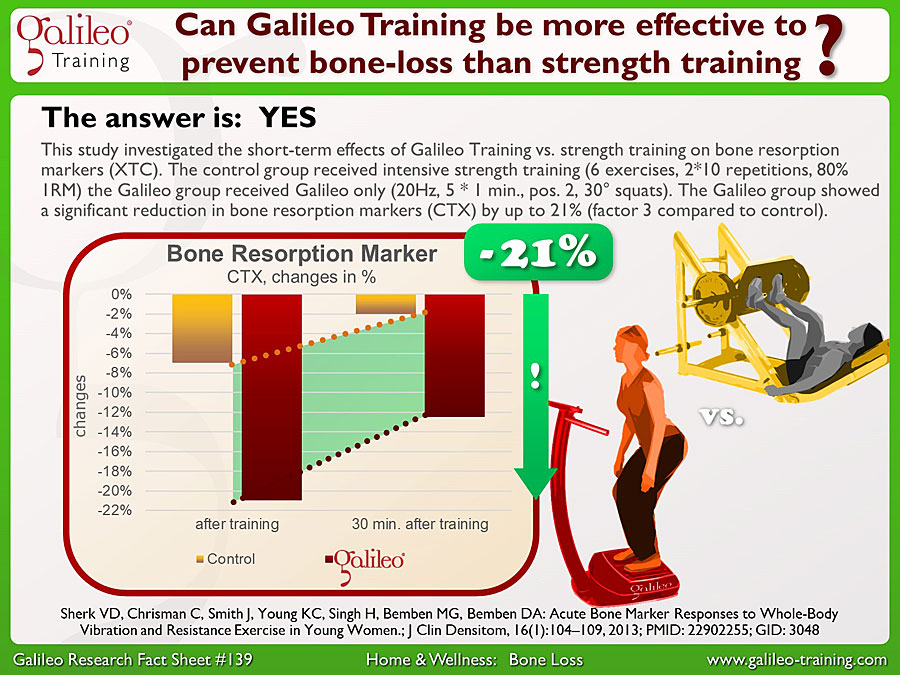In the 2nd Berlin Bedrest Study (BBR2) the effects of Galileo Training against the expected bone loss was tested (55 days, 24Hz, 6x1 min. exhaustive, 3/week). The control groups receive no training or identical training with-out vibration (RE). Compared to both control groups, the Galileo group showed a decrease in vertebra bone marrow fat fraction and in increase in number of red blood cells - both are related to increased endurance...
This study investigated the effects of squats and heel raises with extra loads on muscle function and cross-section with and without Galileo Training at 40Hz (20-40Hz, pos. 3-4, loads 80% 1RM (80kg), 3x8 squats (4 sec.), 3x12 heel raises, 6 weeks, 16 Sessions). The Galileo Group showed higher training effects with increases of isometric torque (up to +4%) and the speed indicator reactive ground contact time (-8%, Drop Jump)...
In the 2nd Berlin Bedrest Study (BBR2) the effects of Galileo Training against the expected bone loss was tested (55 days, 24Hz, 6x1 min. exhaustive, 3/week). The control groups receive no training or identical training with-out vibration (RE). While the control groups showed significant decrease in vascular parameters like dilator capacity or vascular diameter, the Galileo Group could even improve some of them (Vascular Stiffness)...
This study documented the effects of Galileo Therapy on Balance and muscle function in COPD patients. Both groups received endurance training (15 min.) + strength training (50 Min) 5/week, as well as additional 4*2 min. squatting exercises with or without Galileo (24-26Hz, pos. 2.5, 3/week, 3 weeks). The Galileo group showed significantly higher effects on Balance with improvements of up to 28% (e.g. semi-tandem stance, eyes closed)...
This study investigated the effects of 12 weeks of Galileo Training on bone formation markers and bone density of the spine in physical active students (age 18-23) (15-26Hz, 5-15 min., pos.2, 3/week, 12 weeks). The control group did not receive any additional exercises. While the control group decreased bone density at the spine of by up to 1.7%, the Galileo group could increase the bone density at the spine by up to 2.7%...
This pilot study documented effects of Galileo Therapy on bone architecture in patients with pope disease (20Hz, pos. 2, 4 Min., 3/week, 15 weeks). One of the patients was ambulatory the other wheel-chair bound. Both patients showed improvements, however the effects where much more pronounced in the wheel-chair bound patient with improvements of trabecular bone density of 12% and in trabecular number of 23%...
This study documented the immediate effects of Galileo Training one force development, torque and range of motion (ROM) (26Hz, 5x60s, stretching of ankle). The control group performed identical exercises without Galileo Mechanostimulation. The Galileo group showed increase stretching effects (+38%) and a significant increase in torque (Platarflexion) by +18%, and an increased force development at lower ankle angles (-7°)...
This study investigated the effects of Galileo Therapy on muscle force and fall-risk in young obese patients (26Hz, pos. 2, 20° squat, 5x60s., 3/week, 6 weeks). The control group performed identical exercises without Galileo. The Galileo group showed significantly higher effects than the control group for example on muscle strength (extensor torque increase by +6%) as well as reduction of fall-risk and fall-rate by -68%...
This study investigated the short-term effects of Galileo Training vs. strength training on bone resorption markers (XTC). The control group received intensive strength training (6 exercises, 2*10 repetitions, 80% 1RM) the Galileo group received Galileo only (20Hz, 5 * 1 min., pos. 2, 30° squats). The Galileo group showed a significant reduction in bone resorption markers (CTX) by up to 21% (factor 3 compared to control)...
This study investigated the effects of Galileo Therapy on the development of Scoliosis. The control group received Schroth-therapy (daily home-based + 2/week physiotherapy). The Galileo group only received Galileo Therapy (4 exercises, 4*3 min., 10-15Hz, 5/week, 6 months). Compared to the control group the Galileo group showed a significant decrease in the scoliosis extent (Cobb-angle) by up to 6% (2.5°)...









